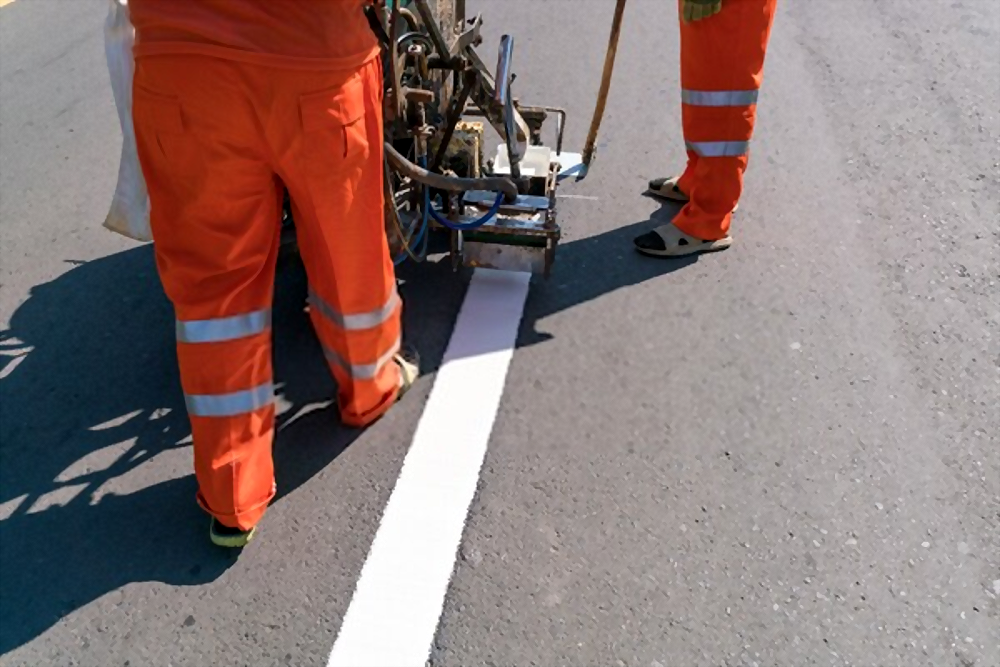Marking Components and Its Role in Thermoplastic Pavement Markings
Thermoplastics are materials usually known as plastic polymers that turn soft when heated and hard when cooled. Today, thermoplastics are greatly applied not only on roads but in all forms of trades such as machines, medical equipment, and packaging. As far as roads and pavements are concerned, the role of thermoplastic markings is an important one. Below is a list of products involved in creating thermoplastic pavement markings.

Hot Melt Marking Paint
As mentioned above, the performance of thermoplastic materials involves cooling and heating. So, when it comes to pavement markings, the process of heating is what is required. The application of thermoplastics for the purpose of pavement marking involves a road paint named ‘hot melt marking paint’. This particular paint is supposed to be heated at a temperature of 392 degrees Fahrenheit. This changes the paint into a liquid-like substance that can be cooled off later once the markings are done. The markings then transform itself into bright, thick, reflective weather- resistant coating which is perfect for making thermoplastic pavement markings.
Profiled Thermoplastic Pavement Marking
Profiled Thermoplastic is one of the variations that are used in thermoplastic pavement markings. It mainly consists of thermoplastic materials used to create a bump or an inversion, thus creating a raised profile marking. Profiled thermoplastic pavement marking is also used for its visibility and durability factor that it has to offer in wet pavement conditions. Furthermore, profiled thermoplastic markings are also known as rumble lines, as they are often used as longitudinal rumble strips.
Preformed Thermoplastic Marking Tape
As the name suggests, preformed thermoplastic marking tape is a preassembled thermoplastic sheet used on the pavement surface. Preformed thermoplastic pavement markings are first placed on the pavement surface and then melted through heating via propane torch. Preformed thermoplastic marking tapes are manufactured to specified shapes and sizes ready for application. Preformed tapes are not made with pre-applied adhesive, rather they are bonded to the pavement thermally. There are two basic forms of preformed thermoplastic marking tapes, one of which does not require the road or pavement surface to be in a pre-heated condition before applying, while the other does.
Two-Component Pavement Marking
Two-component pavement marking is an advanced marking method used for the purpose of durability in extreme weather conditions. The name ‘two-component’ derives from the paint used in the marking system that changes into a solid form when mixed together. The paint mainly consists of curing and cold plastic paint that is mixed straight away before applying. Two-component pavement markings are useful in providing resistance to snow plowing machines and can survive between 2-4 years. The two-component pavement marking system is single-handedly responsible for the longevity of thermoplastic pavement markings.
Thermosets (polyester, epoxy), MMA, and Polyurea are the most basic examples of a two-component pavement marking system.
Glass Beads for Pavement Markings
Glass Beads have been known for adding their reflecting properties in pavement markings in order to increase visibility. Glass bead is a transparent colorless ball with a function of focusing, light refraction, and directional reflection. Hence, whenever a certain light ray is dispersed into the bead, it is refracted and reflected. The refractive index of beads used in pavement markings generally lies between 1.5 and 1.9. With such properties, glass beads play an important role in maintaining road and pavement safety.

Conclusion
The application of thermoplastic pavement markings is one of the most crucial aspects of creating a safe and efficient roadway. Pavement constructed with thermoplastic properties has always been able to commute with road users more than any traffic control device. Hence, one shall not ever compromise with the quality of materials used for pavement markings.





0 comments